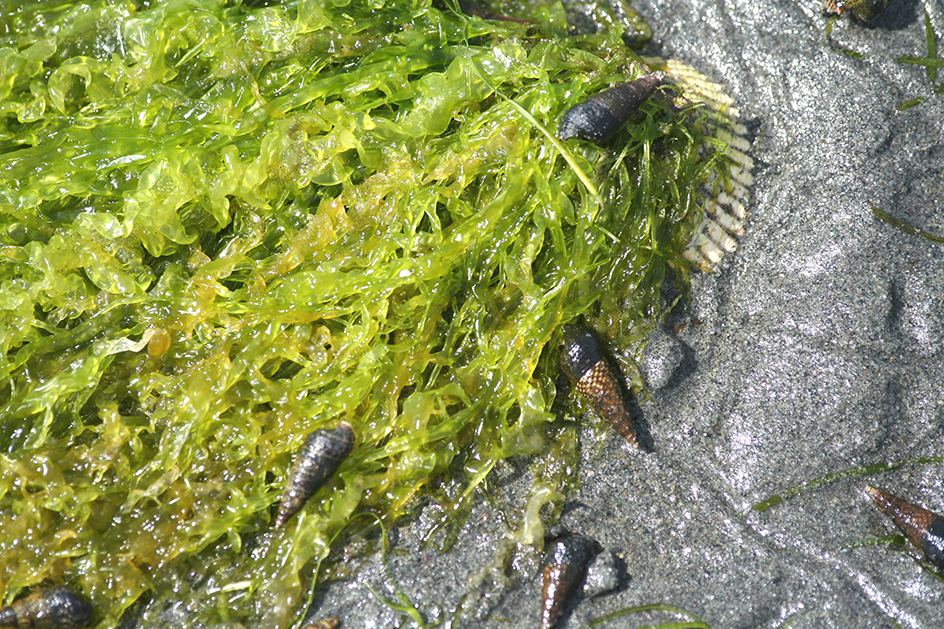Seaweed is a name applied to almost any plantlike marine organism large enough to be seen with the unaided eye. Seaweeds grow in underwater beds, float on the sea surface, attach to rocks and piers, and wash up on shore. Some seaweeds have tall and highly branched bodies, while others form thin and delicate sheets. A few develop as hard, crusty patches on rocks.
Like most plants, seaweeds contain a green pigment (coloring matter) called chlorophyll. Chlorophyll enables seaweeds to make their own food through a process called photosynthesis. In this process, plants and other organisms use energy from sunlight to turn carbon dioxide and water into sugar. The sugar not only fuels a seaweed’s own growth and development, it also serves as food for animals that feed on seaweeds. In addition, many marine creatures find shelter in seaweed beds and use the beds for spawning (reproducing).

Kinds.
There are about 10,000 species (kinds) of seaweeds. All species belong to a group of simple organisms called algae (see Algae). Algae lack true roots, stems, leaves, and flowers. But their durable, flexible structures enable them to survive in marine habitats.
Marine algae live from the polar seas to the tropics. Most grow near coasts, where they attach to rocks, shells, or the sea floor. A rootlike part called a holdfast anchors larger seaweeds to solid objects and prevents them from being washed away. Unlike a true root, the holdfast is not specialized to absorb water and minerals.
A frond, which resembles a stem and leaf, extends from the holdfast. The soft, flexible fronds of a seaweed can sway with the water without being torn apart. Some seaweeds have gas-filled swellings on their fronds. These swellings keep the frond afloat.
Seaweeds belong to the brown, red, and green algae groups. Brown algae get their name from a brown pigment that obscures their green chlorophyll pigment. Most brown algae live in cold water and can grow very large. For example, the giant kelp found off North America’s west coast reaches up to 200 feet (61 meters) long. Brown algae called gulfweeds prefer warm water. Gulfweeds, sometimes known as sargassum, grow in large, floating masses over an area of the North Atlantic Ocean called the Sargasso Sea. Since the 2010’s, blooms (dense masses) of sargassum in the Atlantic Ocean have reached unprecedented sizes. Blooms in the spring and summer may include over 24 million tons (22 million metric tons) of sargassum and extend from the west coast of Africa into the Gulf of Mexico. The exact cause of the giant blooms is not known, but scientists believe one factor is an increased amount of nitrogen in the seaweed’s environment. 
Most red algae are small and delicate, with a feathery or highly branched appearance. They prefer warm water and are particularly abundant in tropical and subtropical seas. Red pigments mask the chlorophyll pigment in these algae.
Some green algae are also considered seaweeds. Mostly small in size, such types inhabit both warm and cold seas. They clearly reveal the green color of their chlorophyll.
Uses.
The name seaweed incorrectly implies that these organisms have little value. People worldwide eat seaweeds, which provide a rich source of vitamins and minerals. Seaweeds also have numerous industrial uses. Brown algae yield a gummy substance called algin, and red algae produce jellylike substances called agar and carrageenan. Manufacturers add these substances to various foods and drugs to give them a smooth texture and help them retain moisture. People also use carrageenan in making paper, spark plugs, and toothpaste; and algin in making buttons, paint, and soaps. Agar also serves as a culture medium, a base on which bacteria are grown in scientific laboratories. See Bacteriology (Studying bacteria). In addition, some seaweeds have become valuable crops.

